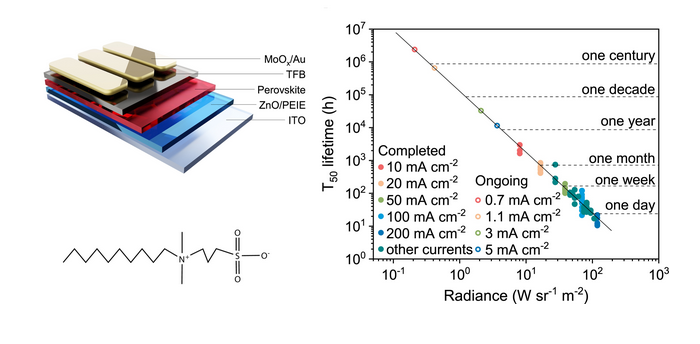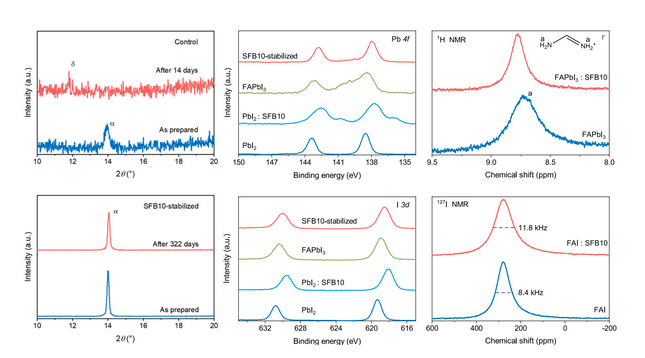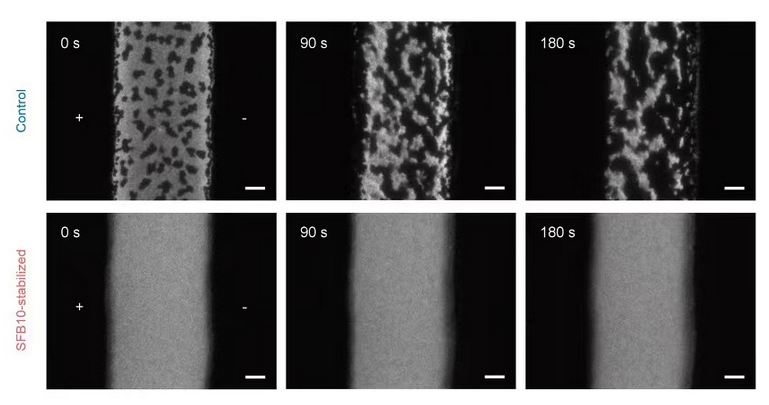Perovskite light-emitting diode (perovskite LED) is a new generation of light-emitting technology with great potential in display, lighting, communication and other fields. Perovskite LEDs have low production costs and significant technical advantages: they have the characteristics of lightness, thinness and flexibility similar to OLEDs, and also have similar color purity and spectral tunability to III-V semiconductor LEDs. After only a few years of development, the efficiency of perovskite LEDs is comparable to that of mature light-emitting technologies.

Perovskite LED device structure (top left);
Chemical formula of bipolar molecular stabilizer SFB10 (bottom left)
Relationship between device T50 lifetime and radiance (right graph)
However, similar to perovskite solar cells, the instability of perovskite LEDs is the biggest challenge for realizing industrial applications. At present, the lifespan of high-performance perovskite LEDs is generally on the order of 10-100 hours. The lifespan required for OLED technology to enter into industrialization is at least 10,000 hours. There are significant challenges in this direction because perovskite semiconductors can be intrinsically unstable. It is good for LED display. Its crystal structure has significant ionic properties, and ions move easily under the applied electric field of the LED, causing the material to degrade.
Recently, the team of Professor David Di and researcher Zhao Baodan from the State Key Laboratory of Modern Optical Instruments, School of Optoelectronics, Zhejiang University and the
International Research Center of Advanced Photonics, Haining International Campus, have made important breakthroughs in this direction. Using a bipolar molecular stabilizer, they achieved ultra-long operating lifetimes in perovskite LEDs that meet the needs of practical applications.
"These perovskite LEDs were driven by a constant current of 5 mA/c㎡ for 5 consecutive months (3600 hours) with no brightness drop," said David Dee. LED perception. For P1.56 LED display. These devices are very stable, and some tests that are still in progress appear to be difficult to complete within a year or more. In order to obtain lifetime data within a reasonable experimental period, LED accelerated aging experiments need to be carried out.”
These near-infrared perovskite LEDs exhibit ultra-long operating lifetimes. For example, with an initial radiance of 2.1 W sr-1 m-2 (current of 3.2 mA/c㎡), the estimated device T50 lifetime (the time it takes for the initial radiance to decrease to 50%) is 32675 hours (3.7 year). The optical power provided by this radiance is comparable to a commercial green OLED operating at a high brightness of 1000 cd/m2. At a lower radiance of 0.21 W sr-1 m-2 (1/10 of the above brightness) or a current of 0.7 mAc㎡, the T50 lifetime is estimated to be 2.4 million hours (about 270 years).
"We believe it is necessary to perform a reliable lifetime analysis of this new LED, for which we collected 62 device lifetime data points in accelerated aging experiments, covering the widest possible current density of 10-200 mA/c㎡ range." Guo Bingbing said. The electroluminescence external quantum efficiency (EQE) and energy conversion efficiency (ECE) of the device reached 22.8% and 20.7%, respectively, which are the highest efficiencies of near-infrared perovskite LEDs.
The authors found that these perovskite luminescent materials have very stable crystal structures. "The crystal structure of the material has not changed after more than 322 days," Zhao Baodan said.

Long-time working and accelerated aging experiments of perovskite LEDs (left image);
External quantum efficiency data of control and stabilized devices (right panel)
"This shows that the bipolar molecular stabilizer helps the perovskite to maintain its original crystal phase with excellent optoelectronic properties. The crystal structure of the treated control perovskite samples changed significantly and degraded within two weeks."
Ion migration in perovskites is one of the important factors leading to instability, and this problem becomes more serious under the influence of applied voltage in LEDs and Mini LED display. "Our experiments and calculations show that bipolar molecules create chemical bonds or interactions with ions at the perovskite grain boundaries," said Guo Bingbing, "which may be the reason why ion migration becomes difficult in our perovskites. "The electrical and optical experiments we carried out with our collaborators have shown the suppression of the ion movement phenomenon," added Zhao Baodan.
The device life results show that perovskite materials have no "genetic defects" in terms of stability. "New semiconductors, such as metal halide perovskites, are widely considered to be intrinsically unstable, especially at relatively high electric fields, such as in LED applications," said David Dee. "Our results show that achieving stable perovskite devices are not 'mission impossible'".
The ultra-long device lifetime is expected to boost confidence in the perovskite LED field, as it has fulfilled the basic requirement of stability for commercial OLEDs. These near-infrared LEDs can be used in applications such as near-infrared displays, communications, and biology. Although visible-light perovskite devices with similar long lifetimes remain to be developed, the realization of ultra-stable perovskite LEDs paves the way for perovskite luminescence technology to enter industrial applications.
搜索
复制

Observation of ion migration effect of perovskite under electric field by microfluorescence imaging experiment
Post time: Aug-24-2022
